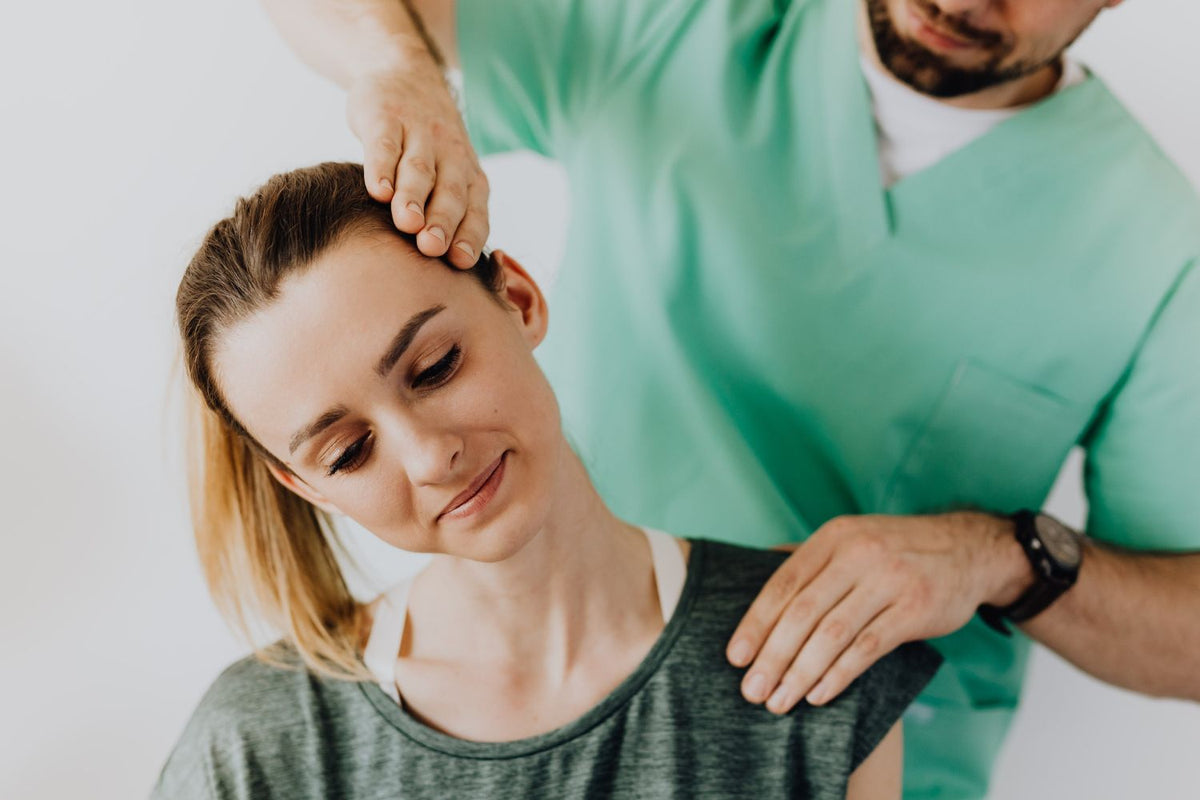Managing Neck Pain and Strains

Wondering what could be causing your neck pain and how to get this symptom under control? From strains to spondylosis and stretches to ergonomics, we’ve gone over the most common causes of neck pain and the best ways to manage it.
Common causes of neck pain
- Pinched nerve: when a nerve in the neck is compressed, it can cause pain, itching, tingling, numbness, weakness, and burning sensations. These may be limited to the neck but can sometimes extend to the shoulders and arms. Generally, pinched nerves come about due to disk generation brought on by aging and natural wear and tear. They may also occur through acute injury or even sleeping in the wrong position.
- Muscle tension: tense muscles around the neck and shoulders (like the trapezius) can also cause stiffness, spasms, and pain when moving the neck in certain directions or outside the constricted range of motion. Tension can develop for many reasons, including poor posture, excess strain, and even stress.
- Stress: when you’re stressed, your muscles contract. And if the source of your stress is ongoing (like a difficult, long-term project at work), the resulting muscle tightness will stay much longer than needed. As a result, you may get neck pain, stiffness, and even tension headaches and migraines.
- Strain: you can strain one or more of your neck muscles, usually through poor posture or an acute injury. You’ll likely experience a sharp or dull, throbbing pain localised to your neck. This pain will usually worsen with movement.
- Arthritis: cervical spondylosis is very common and gets more so with age. Other risk factors include a prior injury that didn’t heal properly (posttraumatic arthritis), genetics, and autoimmune disorders (rheumatoid arthritis). In many cases, cervical spondylosis doesn’t cause any symptoms. But in others, pain, stiffness, a ‘grinding’ sensation when moving the neck, loss of balance, and weakness and pain in the arms may be felt.
How to manage neck pains, strains, and arthritis
Hot and cold therapy
Ice is great for relieving pain and swelling after an injury. It can also take the edge off a pinched nerve. A heat pack, meanwhile, is an excellent way to relax the muscles and fight persistent tension.
You should apply an ice pack for 15-20 minutes at a time, a few times a day. Ideally, you should do so in the first few days of your injury. You can apply a heat pack for 20 - 30 minutes at a time a few times a day. If your neck pain is the result of an injury, avoid using a heat pack for the first three days, as it can worsen swelling.
Exercises to relieve neck pain and tension

Chin tuck
- Stand upright and squeeze your shoulder blades together. This shoulder squeeze naturally lifts your head to the correct starting position.
- Nod your head inward and downward. Your ears should slightly rotate throughout the exercise, but they shouldn’t shift forward or backward as you nod.
- Do 3 sets of 15-20 tucks.
Sideways neck stretch
- Stand upright with rounded shoulders and a neutral spine
- Place your left hand on your head with your fingers pointing towards the ear
- Gently pull your neck to the left until you feel a slight stretch on the right side
- Hold the position for 20-30 seconds, then release
- Repeat for the other side
Neck release
- Stand up straight with your arms at your sides.
- Lower your head and bring your chin toward your chest.
- Gently tilt your head towards the right side and hold the position for 30 seconds. You should feel a stretch on the left side of your neck.
- Gently roll your head back to the centre and lift it back to the starting position.
- Repeat before changing sides.
- Do 3 to 5 times on each side.
Cat cow
- Get on all fours on a yoga mat.
- Your palms should be flat on the mat directly under your shoulders. Your knees should be positioned directly under your hips.
- Inhale, drop your belly toward the mat and lift your chin and chest so you’re looking up at the ceiling. Hold the position for a few seconds.
- Exhale, pull your belly toward your spine and round your back. Gently drop your head so you feel a slight stretch at the back of the neck.
- Repeat the sequence 10-15 times.
REMEMBER, the neck is a delicate structure. Do these stretches slowly and carefully, paying attention to any pain that may pop up. While these exercises are gentle and relatively safe to do, they may agitate an injury (or even cause one) if done incorrectly.
Some discomfort is normal, especially when starting an exercise rehab program. Your injury or pain point may complain (especially if you’ve been trying to keep your neck still or never really stretched or worked out the neck before).
Try a neck brace

CerviLoc Neck Brace
The CerviLoc Neck Brace is ideal for instability, easing pressure in the cervical spine, and preventing damaging movements following an injury. While providing firm support, the brace will soothe the neck and upper back muscles.
With an anatomical fit and breathable design, you’ll get optimal protection and comfortable wear.
Do note, though, that the CerviLoc immobilises the neck. So, while it’s great for pinched nerves, disk degeneration, and acute injuries requiring immobilisation to heal, it might not be suitable for more minor issues like tension. These are better resolved through exercise and ergonomic changes.
Give your neck a break
If you feel tension or pain worsening (for example, when hunching over your laptop for long hours), it’s time to switch positions, go for a walk, do some stretches, or even lay down on a neck-friendly pillow.
See a physiotherapist or osteopath
Physiotherapists and osteopaths can do wonders for neck pain. Depending on your condition, they can manually manipulate the vertebrae into proper alignment, massage tension out of the muscle, and prescribe an exercise routine specific to your case.
Make some ergonomic adjustments
Poor posture is often the primary culprit behind neck pain. And even if it isn’t, it can exacerbate the underlying condition that’s causing it and worsen your pain. So, make some ergonomic adjustments.
- Position your computer monitor so it’s eye-level
- Update your lens or glasses prescription to avoid instinctively leaning forward or back to see something better.
- Use earbuds or the hands-free function on your phone. That way, you won’t need to hold it in the crook of your neck and shoulder while you’re busy cooking or typing.
- DO NOT bend your neck down to look at your phone. Instead, try to bring your phone up to eye level.
Medications for neck pain
Over-the-counter pain relief can also help, though most experts advise not solely relying on it. It’s always best to combine pain medication with active management steps like exercise and physiotherapy, as medication addresses the symptom and not the cause.
To sum up
Neck pain can develop for many reasons, from sleeping wrong to gradual disk degeneration. But more often than not, conservative treatment methods like physiotherapy, exercise, and bracing can help heal damaged tissues (or, at the very least, get the pain under control.)
More information
If you require assistance selecting the right product for your needs or wearing the brace, call us on 1300 668 466 or contact us via live chat.
Do you have private health? Most private health extras will cover Bauerfeind Products. Check to see if yours is included. Bauerfeind Private Health Insurance Inquiry.
Bauerfeind was founded in 1929, and since then, we've worked tirelessly to develop and improve our extensive range of braces, insoles, and compression products. Our mission is to provide you with top-of-the-line supports so you can reach your fitness goals or live life without pain holding you back.
Every product is produced entirely in our facilities in Germany with the guidance of doctors, clinics, and orthopaedic technicians.



